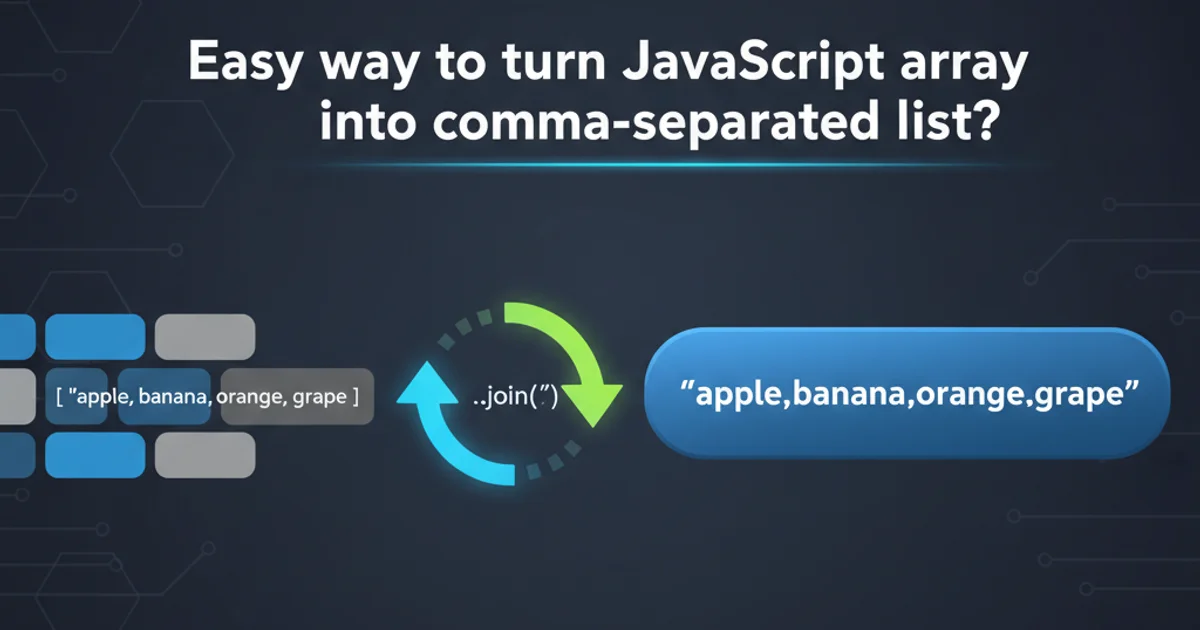Easy way to turn JavaScript array into comma-separated list?
Categories:
Effortlessly Convert JavaScript Arrays to Comma-Separated Strings

Learn the simplest and most efficient methods to transform a JavaScript array into a clean, comma-separated list, covering common use cases and best practices.
Converting a JavaScript array into a comma-separated string is a common task in web development. Whether you're preparing data for display, sending it to a server, or generating a list for user output, knowing the right methods can save you time and make your code cleaner. This article explores the most straightforward and effective ways to achieve this transformation, focusing on built-in JavaScript functions.
The Array.prototype.join() Method: Your Primary Tool
The join() method is the most direct and idiomatic way to convert all elements of an array into a string. It concatenates all elements into a single string, separated by a specified separator string. If no separator is provided, the array elements are separated by a comma by default.
const fruits = ['apple', 'banana', 'orange'];
// Using default comma separator
const defaultList = fruits.join();
console.log(defaultList); // Output: "apple,banana,orange"
// Specifying a comma and space separator
const spacedList = fruits.join(', ');
console.log(spacedList); // Output: "apple, banana, orange"
// Using a different separator, e.g., a hyphen
const hyphenatedList = fruits.join(' - ');
console.log(hyphenatedList); // Output: "apple - banana - orange"
Basic usage of Array.prototype.join()
join() method is highly optimized for this specific task. Avoid manual iteration and string concatenation for better performance and readability.Handling Edge Cases and Data Types
While join() is powerful, it's important to understand how it handles different data types and edge cases like empty arrays or arrays containing null or undefined values. The method automatically converts non-string elements to strings before concatenation.
const mixedArray = [1, 'two', true, null, undefined, { key: 'value' }];
const mixedList = mixedArray.join(', ');
console.log(mixedList);
// Output: "1, two, true, , , [object Object]"
const emptyArray = [];
const emptyList = emptyArray.join(', ');
console.log(emptyList); // Output: "" (an empty string)
const arrayWithEmptyStrings = ['one', '', 'three'];
const emptyStringList = arrayWithEmptyStrings.join(', ');
console.log(emptyStringList); // Output: "one, , three"
How join() handles various data types and empty elements
flowchart TD
A[Start: JavaScript Array] --> B{Call .join(separator)?}
B -- No separator --> C[Default: ',' separator]
B -- Yes, separator --> D[Use provided separator]
C --> E[Convert each element to string]
D --> E
E --> F[Concatenate strings with separator]
F --> G[End: Comma-Separated String]Flowchart of the Array.prototype.join() process
Advanced Scenarios: Filtering and Mapping Before Joining
Sometimes, you might need to process array elements before joining them. Common scenarios include filtering out unwanted values or transforming objects into specific string representations. This can be achieved by chaining filter() and map() methods before join().
const users = [
{ id: 1, name: 'Alice' },
{ id: 2, name: 'Bob' },
{ id: 3, name: 'Charlie' }
];
// Get a comma-separated list of user names
const userNames = users.map(user => user.name).join(', ');
console.log(userNames); // Output: "Alice, Bob, Charlie"
const numbers = [1, 0, 5, null, 10, undefined, 2];
// Filter out falsy values and join valid numbers
const validNumbers = numbers.filter(Boolean).join(', ');
console.log(validNumbers); // Output: "1, 5, 10, 2"
Chaining map() and filter() with join() for complex transformations
join() will call toString() on each object, which often results in [object Object]. Use map() to explicitly extract the desired property or format the object into a string before joining.